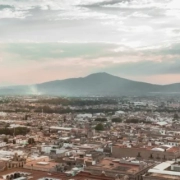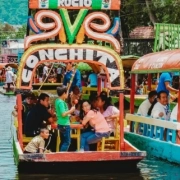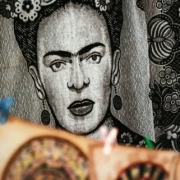Who among us hasn’t dreamed of stepping into Indiana Jones’ shoes as a child? Who hasn’t been captivated by the breathtaking adventures of Jules Verne’s heroes? Who hasn’t sympathized with Tom Sawyer as he wandered through a cave? Chichen Itza is the place in sun-drenched Mexico where these dreams come to life. Ancient temples and pyramids, unique acoustics, and complex mathematical calculations — all created by a civilization that didn’t even know the wheel.
Download an audio guide to Chichen ItzaToday, we journey to Chichen Itza, an ancient Mayan city lost to time and rediscovered.
Flying to the south of Mexico, we head toward the Yucatán Peninsula. Below us, the jungle stretches endlessly, a sea of green. Yes, Mexico is not just cacti and deserts — though corn tortillas are indeed found at every turn!
» READ MORE – Sochimilco: 700 years of history at the site of an Aztec lake
The closest international airport to Chichen Itza is in Cancun, a popular holiday destination (here’s your transfer). Pristine beaches, vibrant southern Mexican cuisine, and, if it’s your thing, an energetic nightlife await. You can stay here and unwind at the Hyatt Zilara Cancun on the coast or opt for the Casas Calis Cancún in the city center.
All Cancun hotelsAlternatively, you can head straight into the jungle, closer to the ancient ruins. There are two options: a pre-arranged tour with transfers and meals or traveling independently.
You can reach Chichen Itza by rental car, local minibus, or bus. We recommend taking an audio guide — it will be with you throughout your visit and works offline.
Before you leave modern civilization behind, be sure to bring a wide-brimmed hat, insect repellent, and a water bottle. Don’t forget sunscreen with the highest SPF—the Mexican sun is generous with its warmth.
» READ MORE – Chichen Itza: The Mayan City of Mexico with an Audio Guide from TouringBee!
Discovering a Lost City
Why is it called a lost city? Because even before the arrival of Europeans, Chichen Itza had twice flourished and then fallen into decline. Each time, its inhabitants abandoned it, and the jungle reclaimed it.
The city was founded by the Maya in the 5th century AD. In the mid-10th century, the warlike Toltecs captured, destroyed, and rebuilt it, making it the capital of their state. By the time the Spanish conquistadors arrived, the city had fallen into ruin again — this time due to soil erosion and famine, which led to the collapse of the local civilization.
The Spanish zealously enforced Catholicism, destroying Mayan written records as heretical. Today, we are left with only the ruins of ancient temples, the accounts of Spanish missionaries, and the oral histories passed down by the Maya’s descendants. Much of Chichen Itza remains a mystery.
What Will You See When You Arrive?
The archaeological site spans 1,547 hectares — roughly 4.5 times the size of Central Park in New York City. Scattered across this vast area are several dozen ancient structures in various states of preservation.
- Photography is allowed, but drones and tripods are prohibited
- Climbing the pyramids is forbidden — viewing is only permitted from the ground
- Chichen Itza is open from 8:00 AM to 5:00 PM (Tuesday-Sunday); it is closed on Mondays
- The ticket office closes at 4:00 PM
- If traveling without a group, you may be asked to show your passport
Kukulkan Pyramid
The most iconic structure in Chichen Itza, this pyramid is dedicated to Kukulkan, the god of wind, water, fire, and air, whom the Maya believed to be the creator of the world. According to legend, Kukulkan taught the Maya farming, fishing, and hieroglyphic writing, turned their gaze to the stars, and devised their calendar.
The pyramid has 364 steps, and with the top platform included, it totals 365 — one for each day of the year.
On the days of the equinoxes, a remarkable light and shadow effect occurs: the feathered serpent, the supreme deity of the ancient Maya, appears to slither up the pyramid in March and down in September.
Temple of the Warriors
This temple is an exact replica of the Temple of Quetzalcoatl in Tollan, the homeland of the Toltec leader. The Toltecs — relatives and predecessors of the Aztecs — were a fascinating civilization. They began their journey in the north and gradually migrated south in search of warmer lands. Both great artists and fierce conquerors, they paradoxically combined creativity with military prowess. Upon taking control of Chichen Itza, they reconstructed their native temples here.
At the top of the temple stands a sculpture of Chak Mool (a general term for pre-Columbian stone statues). According to legend, blood sacrifices were made on its altar, and hearts were placed on its stone platter.
In front of the temple, a platform with four rows of columns depicts 60 warriors — each with a unique face, no two alike.
Temple of the Jaguars
This pyramid-within-a-pyramid features a stone throne shaped like a mighty jaguar, a symbol of power. It is painted deep red and adorned with jade inlays.
Nearby lies the Great Ball Court, where the Maya played the ritual game of pok-ta-pok. It is believed that from the Temple of the Jaguars, priests and rulers observed matches that determined not only the fate of the players but also the will of the gods.
For a deeper understanding of this ancient site, our Chichen Itza audio guide will reveal more fascinating details.
El Caracol Observatory
Built around 906 AD, the observatory’s name translates to «snail» due to its spiral staircase. Though the dome has been destroyed, three irregularly spaced windows remain. According to scholars, one could only observe the sky from this observatory while lying down. Interestingly, it was the Maya — long before the Hindus and Arabs — who first developed the concept of absolute zero.
Northern Temple
The Temple of the Bearded Man is named for a bas-relief depicting a bearded figure — an unusual feature in Mayan culture. The temple is famous for its unique acoustics: whispers can be heard from anywhere in the hall. This phenomenon was likely used in rituals or ceremonies.
And that’s just the beginning. There’s also the Temple of Skulls, the Temple of Venus, the Tomb of the High Priest, and the Platform of Jaguars… But to preserve the thrill of discovery for you, we won’t reveal everything here. Chichen Itza is best explored firsthand.
» READ MORE – Mexico City’s Museum of Anthropology: a world of ancient civilisations under one roof
The Sacred Cenote and the Cenotes
The dark legends of Mayan (and Aztec) rituals have long fascinated writers and filmmakers. Some are pure fiction — others, historical reality.
The Sacred Cenote, located just 100 meters from the main temple, is unlike the others. Most cenotes — circular karst lakes abundant in the Yucatán — are breathtakingly beautiful, with crystal-clear blue waters where visitors can swim.
But this one is different — its murky green waters have no visible approaches or descents. According to legend, the Maya considered it a gateway to another world, where human sacrifices were made. Archaeologists have found numerous skeletons, gold, pottery, and even furniture at the bottom.
Fortunately, only this cenote holds such a grim past. The rest of the Yucatán is filled with life and vibrant energy.
Today, hotels have been built around some cenotes as an alternative to beach resorts. Here, you can feel like a successful conquistador — crossing the peninsula, discovering new wonders, but with the added luxury of modern service. Expect crisp white sheets, excellent coffee, and ice-cold beer.
A Souvenir to Remember
The descendants of the ancient Maya — and Mexicans in general — have a unique perspective on death, reflected in many of their souvenirs. However, you’ll also find brightly colored textiles, jaguar masks, and intricately painted ceramics. Authentic hats, quartz, and obsidian crafts are also popular.
Life should be filled with memories and experiences. And what could be more satisfying than casually saying, «By the way, while crossing northern Yucatán, I stopped at the most incredible place…»
» READ MORE – Not just Mexico City: Mexico’s 10 colourful cities for tourists




 Nan Palmero / Flickr / CC BY 2.0
Nan Palmero / Flickr / CC BY 2.0  Jezael Melgoza / Unsplash
Jezael Melgoza / Unsplash  Israel Caballero / Unsplash
Israel Caballero / Unsplash  Armando Olivo Martín del Campo / Wikimedia Commons / CC-BY-SA-4.0
Armando Olivo Martín del Campo / Wikimedia Commons / CC-BY-SA-4.0  Roberto Carlos Román Don / Unsplash
Roberto Carlos Román Don / Unsplash  Tim Mossholder / Unsplash
Tim Mossholder / Unsplash  Armando Olivo Martín del Campo / Wikimedia Commons / CC-BY-SA-4.0
Armando Olivo Martín del Campo / Wikimedia Commons / CC-BY-SA-4.0 Pixabay
Pixabay
Leave a Reply
Want to join the discussion?Feel free to contribute!